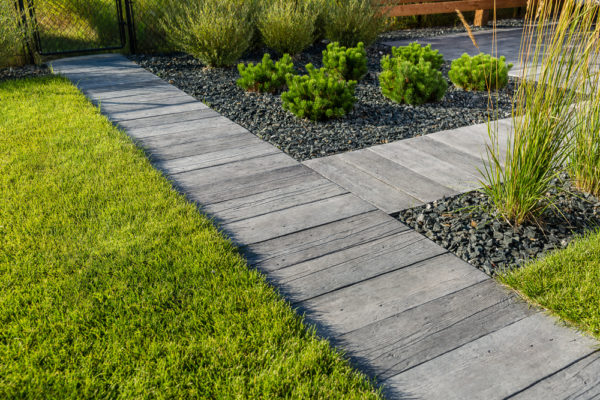Written by Jason Plett Published on August 1st, 2018

Bridgewood Slab is a wonderful and unique concrete product designed to look like old, weathered wood. With it you can achieve beautiful rustic designs and aesthetics impossible with other more traditional precast concrete slabs or bricks. The Bridgewood Slab is now a family of products that include the Bridgewood Step and Bridgewood Wall, all having the same look of wood and the durability of concrete.
Like any other product, there are different ways that will help enhance the Bridgewood Slab in any installation. Here are 3 tips for installing Bridgewood in your own backyard.
- Where to Get Inspiration
Bridgewood is inspired by real wood, so it will be very helpful to look at different wood applications in gathering ideas for your Bridgewood patio or path. Before laying any slab, research different designs of wood floors or paths to draw ideas from so you can create a space as unique as the product you are using. This Bridgewood path was inspired by a boardwalk and was designed to mimic that aesthetic.
- How to Lay Bridgewood
Laying Bridgewood can be a little bit tricky simply due to its size and weight. The lightest of the three sizes weighs in at 28 lbs. and the heaviest is more than double at 58 lbs., so, needless to say, Bridgewood can sometimes be cumbersome to handle. There are however a few tricks to laying the product. The first is obvious: get help. Having someone to either help you lift the slabs or lay every other slab down will dramatically cut your work time in half. Secondly, use the slabs already laid as a guide to lay your next slab. While laying the slab, put the new slab up against the slabs already laid to provide stability and support while lowering the slab. This ensures that the slabs go in the right place and will prevent disturbances in the screeded sand layer beneath it, which could cause shifting in the patio. And when installing Bridgewood slabs, make sure to include a 1/8” to ¼” gap between each slab. This will allow even spacing for the jointing sand and for easier installation.
- How to Apply Polymeric Sand
If you create a path or patio out of Bridgewood, you may choose to use polymeric sand to fill the joints between the slabs. This can prevent weed growth and will keep the patio or path firmly in place. However, due to the nature of the Bridgewood slab and its many decorative grooves that make up the wood grain design, it is good to note that the normal process of dumping and sweeping the sand all around your patio to fill the joints may not be the wisest choice. The sand will get into the cracks on the slabs and when you water the patio to set the sand, you will lose the authentic wood grain look. To avoid this, carefully fill the joints with sand trying to keep the sand just in the area of the joints. We find putting the sand into smaller bags makes this process easier. Once you are done, carefully sweep the patio to make sure there is no sand left in any of the wood grain and you will have a patio that pops with detail.












